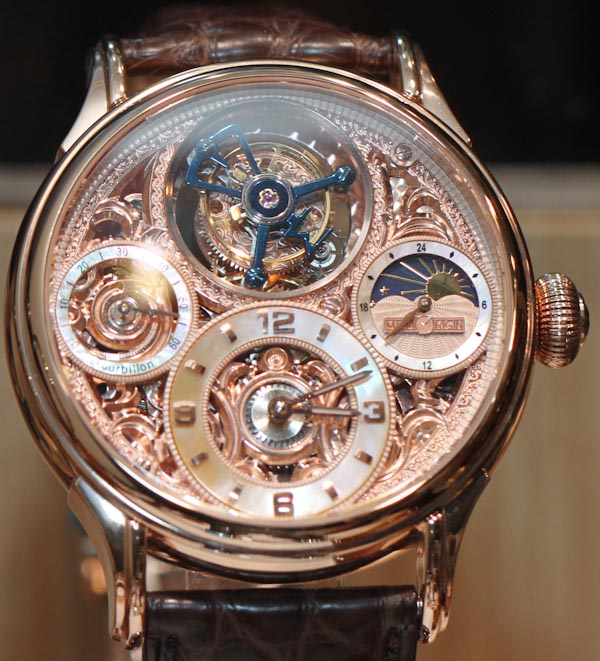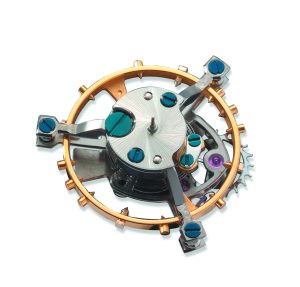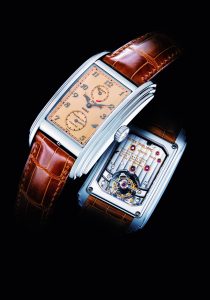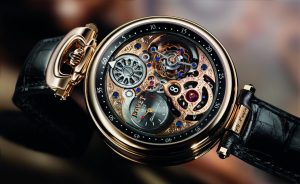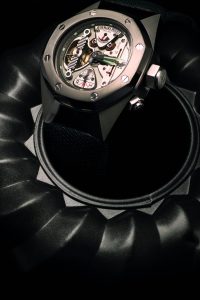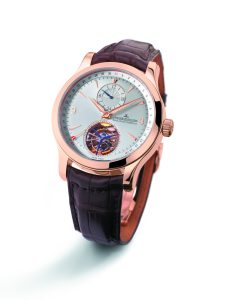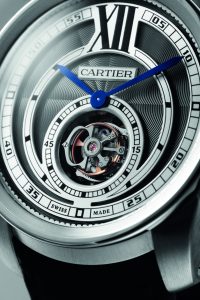The tourbillon was a rarity, till the resurgence of interest in mechanical horology sparked its rebirth in recent years.
Rationale
Of all the complications invented by Abraham-Louis Breguet, perhaps none exemplifies the horological challenges of his era better than the tourbillon. It was invented by Breguet around 1795, although Breguet’s patent for the device was not submitted until 23 December, 1800. His patent reads:
“By means of this invention, I have succeeded in cancelling through compensation the anomalies caused by the different positions of the centers of gravity of the regulator movements, to distribute frictions on all parts of the circumference of this regulator’s pivots and of the holes in which these pivots move, so that the oiling of the friction surfaces is always even, in spite of oil coagulation, and finally to cancel many other causes of error influencing movement accuracy, which could only be attained until now by constant trial and error and often even without any certainty of success.”
Though it also enabled more sophisticated oil distribution, generally it is agreed that the tourbillon was developed to address gravity’s insidious effect on a pocket watch’s accuracy. A pocket watch may adopt several positions throughout the day, but of these positions, the vertical, where gravity would cause the delicate hairspring to deform, was the most common as pocket watches were worn vertically in waistcoat pockets. Breguet’s invention was intended to create a watch in which the escapement and balance rotated through all possible vertical positions at a steady rate, so as to produce a consistent, averaged rate for all vertical positions which could then be easily adjusted. The name tourbillon literally means “whirlwind” in French, a nod to the way the mechanism rotates on its own axis.
Tourbillon cages may take on a variety of styles, but like a balance wheel, should have high inertia while being as light as possible.
Dextrous Hands
The tourbillon historically was considered a tour de force demonstration of watchmaking skill as the mounting of the entire escapement and balance within a svelte rotating carriage requires the highest precision in manufacturing and adjustment. Jean-Pierre Musy, Patek Philippe’s technical director, says, “A simple watch with a high oscillating speed and an enormous balance can easily be more accurate than most tourbillons. So if you want to have tourbillons that are truly chronometric, then you must spend many hours regulating the watch. For every tourbillon that leaves Patek Philippe, the regulation process takes months of observation and fine-tuning. Every one of our tourbillons receives a COSC certificate, but they have to pass even higher internal chronometric standards. Mr Philippe Stern [honorary president of Patek Philippe] wants us to achieve the standards of the COSC, divided by three. This is very difficult to achieve and can take hundreds of hours regulating the watch.”
If a chronometric tourbillon is challenging for modern manufacturers like Patek Philippe with access to computers to guide high-precision cutters capable of micron — or better — accuracy, imagine how difficult it was in Breguet’s day, where the construction, finishing assembly and adjustment of components were done by hand.
In Patek Philippe’s Ref. 5101P 10 Day Tourbillon, the tourbillon regulator is positioned at the back of the movement, a style reminiscent of historic tourbillon pocket watches.
Slow Start, 1800 to the 1990s
Since their invention by Breguet, tourbillons have been a rarity until recent years, when the resurgence of interest in mechanical horology sparked the rebirth of the tourbillon. Prior to the ’90s, tourbillons in pocket watches and wristwatches were made by watchmakers and firms who sought to distinguish themselves in both chronometric and artistic excellence. England was bereft of tourbillons until the end of the 19th century, when Frodsham, Smith & Sons and Dent made tourbillons — often submitted for time trials at the Kew Observatory. The total number of tourbillons made between 1801 and 1945 is estimated to be, at most, less than 900, and possibly as few as 600. Indeed, Reinhard Meis, the author of the definitive tourbillon text, The Tourbillon, counts only 250 watchmakers as capable of rendering a true tourbillon by the end of the 20th century.
One of the most remarkable of the vintage tourbillons, and one whose descendants in wristwatch form can be found in limited numbers today, is the Girard-Perregaux Tourbillon with Three Gold Bridges. The design for a tourbillon of this type was patented by the manufacture in the year 1884. These tourbillons were made for the manufacture by Ernest Guinand, a Swiss watchmaker born in 1810 who made somewhere between 20 to 25 tourbillons for Girard-Perregaux, but who also made tourbillons of superb quality for Patek Philippe and others. These watches are in many ways representative of the very finest craft imaginable; the unique arrangement of the bridges combined with the small, extremely fine cage constructed by Guinand made these some of the best-performing pocket chronometers ever created. In 1867, a Guinand tourbillon, No. 1060, was rated at Neuchâtel and showed a maximum gain on its rate of only 0.15 seconds per day, and an amazing temperature failure of exactly zero seconds per grade Celsius.
Other famous tourbillon makers were the American watchmaker Albert Potter, who worked in Geneva and, around the turn of the century, made tourbillons known for very high-quality precision work; and the Dane, Bahne Bonniksen, working in Coventry, England, who invented a variation of the tourbillon known as the karrusel which dispensed with the cage and mounted the entire escapement and balance on a revolving platform. These watches were known for their excellence in keeping a close rate and when submitted to observatory time trials, in the words of the great modern watchmaker and inventor of the co-axial escapement Dr George Daniels, “swept all before them”.
On the Wrist
The tourbillon does not seem to have appeared in a wristwatch until just after World War Two, when they began to appear in extremely small numbers in watches essentially designed to be high-performance timekeepers. Probably the first was a 13¼-line movement made by master watchmaker Andre Bornand for Patek Philippe in 1945. A few years later, in 1948, the French manufacturer Lip made a single tourbillon wristwatch. Around the same year, Omega made a limited series of tourbillon wristwatches.
Patek Philippe also made a very limited series of tourbillon wristwatches during the 1950s. Made for them by Bornand, there appears to have been five built, with not only a Guillaume balance, but also a remarkable bronze-beryllium cage weighing only 1.018 grams. All obtained “first class” observatory ratings, and two won first prize in the Geneva Observatory competitions.
Gaining Momentum, late 20th Century
Like many high-level watchmaking achievements, the making of tourbillons fell fallow during the ascendance of the quartz watch, but in 1986, a watch appeared that would later be regarded as one of the most remarkable tourbillons ever built, and which would be thought of as one of the watches responsible for rekindling the dormant fires of passion for the incandescent whirlwind. This watch, made by Audemars Piguet, was the first automatic tourbillon ever made, caliber 2870, which finally broke the record for miniaturization of the cage, set by Fritz-André Robert-Charrue: the tourbillon cage in cal. 2870 measured 7.2mm in diameter and the entire movement had a height of only 2.5mm. The case itself was actually the top plate of the movement, and viewed from the back, the jewelled pivots for the train could be seen. The cage was made of titanium (another first) and the main bridge was made of gold. This reference remains both the thinnest automatic tourbillon — achieved by using small oscillating weights that charged the barrel by tapping a winding mechanism — and the one with the smallest cage, to this day. As Martin Wehrli, director of the Audemars Piguet museum, says, “While it was perhaps not the most chronometric or functional watch, it can be considered one of the flashpoints of inspiration for the modern tourbillon era, and as such, is endowed with tremendous historic significance.”
Girard-Perregaux reproduced the Tourbillon with Three Gold Bridges for the first time as a pocket watch in 1981. The manufacture then went one step further and reduced the size of the movement to a diameter suitable for a wristwatch, and after a painstaking development process, they were able to release the first Tourbillon with Three Gold Bridges wristwatch in 1991; a watch many feel, in its various forms, is still unsurpassed in sheer beauty. In 1999, cal. 9600, an automatic version, was released boasting a resplendent micro-rotor hovering just above the barrel.
Other modern manufacturers were also investigating and reintroducing the tourbillon. As a complication, it was visually stunning. Who could resist being drawn to the hypnotic rhythms of the constantly rotating cage and the dance of the lithe oscillating balance? It is of note that while tourbillons in pocket-watch form were placed to the back of the watch, starting with Audemars Piguet’s watch, most were constructed with the tourbillon on view dial-side, a savvy statement acknowledging the appeal of the mechanism’s dynamic appearance.
Horological enfant terrible Franck Muller introduced a patented tourbillon in 1995, and Patek Philippe, whose observatory-rated tourbillons had garnered so many accolades in previous decades, debuted a 10-day power reserve tourbillon in 2003, a worthy heir to the Patek chronometers of old. And of course Breguet, whose name is synonymous with the tourbillon, has in the modern era returned to reclaim the throne as king of the tourbillons (based on production numbers).
Excerpted from an article by Yeo Suan Futt in REVOLUTION’s archives.
Source : https://www.revolution.watch/a-brief-history-of-the-tourbillon/

